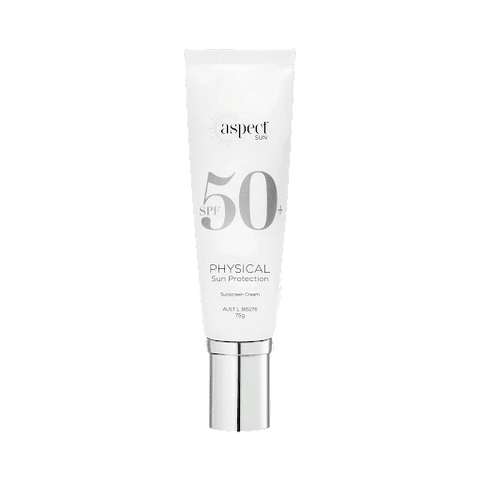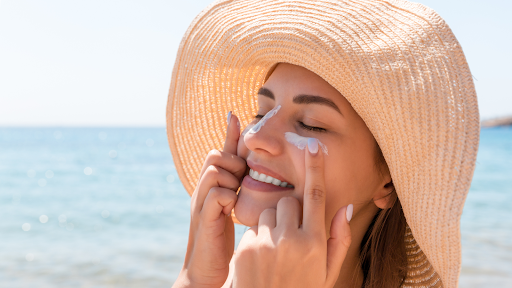If you’re typically the health-conscious type, you may have noticed that sunscreen comes in two types, aside from spray or block. Physical and chemical sunblock are two different sunscreen processes with benefits and downsides.
Neither is patently better than the other — so while your first instinct may be to avoid the chemical sunscreen, there are no health-related complications. However, you may opt for physical sunblock due to its relative environmental friendliness. Chemical sunscreens have been attributed to coral bleaching and environmental harm when mixed into waterways or diluted in the ocean when swimming (although this depends on the sunscreen brand).
When it comes to your health, either choice is acceptable. So here, we’ll explore the different properties, benefits and uses of physical and chemical sunblock.
What’s the main difference between physical and chemical sunblock?
The main difference between the two is how they prevent UV radiation.
Physical sunscreens, also known as mineral sunscreens, reflect UV and UVA-related skin damage from your skin by creating a sunscreen barrier. Essentially, they sit on the surface, preventing UV light from reaching the skin in the first place.
Chemical sunscreens, on the other hand, absorb UV rays before the skin can, without leaving a visible trace. Chemical sunscreens typically use safe UV filters, converting rays into heat and releasing them into the body.
Pros and cons
People with skin sensitivities more easily tolerate physical sunscreen, and it can also be used as a moisturiser with a typically thicker consistency. None of the physical properties of the sunscreen sinks into the skin, which makes it harder to apply. Because they sit on the skin, they’re also not typically the best if you’re looking to swim, as water can wash off the sunscreen.
Chemical sunscreen, by comparison, provides more complete UV protection and is more water- and sweat-resistant, as well as lighter and more absorbent. However, certain sunscreens have been known to irritate skin conditions such as eczema, psoriasis or rosacea.
Chemical sunscreens are completely safe, meaning the ingredients can pass through your bloodstream without causing any harm.
Choosing a sunscreen.
There are a number of sunscreens to choose from, although all have to be independently tested and certified for their SPF claims. Aspect is certified for up to SPF 50, the highest protection range for sunscreens.
Individually, Aspect sunscreens have different properties, depending on the level of protection required and your individual skin requirements.
Physical Sun Protection SPF 50+
It is an ideal sunscreen for sensitive skin or for skin that has recently undergone treatment. Unlike a lot of physical sunscreens, Aspect offers up to 80 minutes of water resistance and leaves no white residue.
As a mineral sunscreen, Aspect also offers hydration and moisturising benefits for your skin, including glycerin, which helps against ageing. The formula also uses zinc oxide to protect against harsh UVA and UVB rays and is certifiably reef-safe, meaning none of the ingredients will cause coral bleaching if exposed to waterways.

Envirostat® Face SPF 50+
This particular sunscreen offers high water and sweat resistance for an active lifestyle, with up to four hours of water resistance. It also offers a lot of antioxidants, helping protect against the ageing effects of UV exposure, including Vitamin E, which helps nourish and strengthen the skin against damage.

CC Cream SPF 50+
Like the other sunscreens mentioned, this offers UVA and UVB protection while adding universal colour-correcting tints to help even skin tones. Also present are antioxidants to help hydration levels.
A similar sunscreen is Tinted Physical SPF 50+, a physical sunscreen that offers sun protection and helps ensure an even skin glow.

Hydrating Face SPF 50+
If you want to improve skin hydration and protect against high UV ray bombardment, hydrating Aspect sunscreen is ideal. This sunscreen combines glycerin, silica, and vitamin E to nourish, protect and smooth over fine lines and help entrap the skin’s natural moisture content.

What’s the best sunscreen option?
There’s no right or wrong option when it comes to sunscreen. All the Aspect ranges offer SPF 50+ protection, the highest rating in New Zealand, preventing UVA and UVB rays. Choosing a sunscreen depends on other concerns you may have, such as skin hydration, even tan, durability, etc.
Whatever sunscreen you choose, it’s recommended that you reapply your sunscreen regularly, every four hours with chemical sunscreen and every eighty minutes with physical sunscreen, particularly if you’re considering heading into the water.
Regularly applying sunscreen will also help prevent premature ageing, sun damage, hyperpigmentation and loss of skin moisture. This is particularly prevalent if you’re considering trying for a tan — in which case, you should read our other blog on tanning, which explores spray tan alternatives for getting that same gorgeous, sunkissed look safely.




